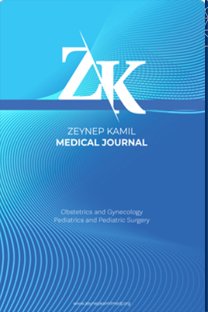Foreign body in esophagus of children with previous esophageal surgery history
Foreign body in esophagus of children with previous esophageal surgery history
___
- 1. Metin B, Öncel M, Yıldırım Ş, Tözüm H. Esophageal foreign bodies in children. Arşiv Kaynak Tarama Derg 2014;23(2):196–86.
- 2. Khorana J, Tantivit Y, Phiuphong C, Pattapong S, Siripan S. Foreign body ingestion in pediatrics: Distribution, management and complications. Medicina (Kaunas) 2019;55(10):686.
- 3. Kamiya KJ, Hosoe N, Takabayashi K, Hayashi Y, Sun X, Miyanaga R, et al. Endoscopic removal of foreign bodies: A retrospective study in Japan. World J Gastrointest Endosc 2020;12(1):33–41.
- 4. Sekmenli T, Çiftci İ, Öncel M, Sunam GS. Esophageal foreign bodies in children. Genel Tıp Derg 2015;25:58–60.
- 5. Kramer RE, Lerner DG, Lin T, Manfredi M, Shah M, Stephen TC, et al. Management of ingested foreign bodies in children: A clinical report of the NASPGHAN endoscopy committee. J Pediatr Gastroenterol Nutr 2015;60(4):562–74 . 6. Smith CR, Miranda A, Rudolph CD, Sood MR. Removal of impacted food in children with eosinophilic esophagitis using saeed banding device. J Pediatr Gastroenterol Nutr 2007;44(4):521–3.
- 7. Köseoğlu B. Treatment of childhood gastrointestinal foreign bodies. Van Tıp Derg 2001;8(2):47–53.
- 8. Ismael G, Varon J, Surani S. Airway complications from an esophageal foreign body. Case Rep Pulmonol 2016;2016:3403952.
- 9. Lee JH. Foreign body ingestion in children. Clin Endosc 2018;51(2):129– 36.
- 10. Fung BM, Sweetser S, Song LM, Tabibian JH. Foreign object ingestion and esophageal food impaction: An update and review on endoscopic management. World J Gastrointest Endosc 2019;11(3):174–92.
- 11. Çobanoğlu U, Can M. Esophageal foreign bodies in 0-7 years old children. Van Tıp Derg 2008;15(2):51–7.
- 12. Tiryaki HT, Akbıyık FF, Şenel E, Mambet E, Livanelioğlu Z, Atayurt HF. Foreign body ingestion in childhood. Türk Çocuk Hast Derg 2010;4(2):94–9.
- 13. Erginel B, Karlı G, Soysal FG, Keskin E, Özbey H, Çelik A, et al. Foreign body ingestion in childhood. Ist Tıp Fak Derg 2016;79(1):27–31.
- 14. Sarımurat N. [Foreign Bodies] I.U. Cerrahpaşa Tıp Fakültesi Sürekli Tıp Eğitimi Etkinlikleri. Pediatrik Aciller Sempozyumu, İstanbul; 2001. p. 125– 30.
- 15. Shivakumar AM, Naik AS, Prashanth KB, Yogesh BS, Hongal GF. Foreign body in upper digestive tract. Indian J Pediatr 2004;71(8):689– 93.
- 16. Hesham H, Kader A. Foreign body ingestion: Children like to put objects in their mouth World J Pediatr 2010;6(4):301–10.
- ISSN: 1300-7971
- Yayın Aralığı: Yılda 4 Sayı
- Yayıncı: Ali Cangül
Serum endocan concentration in women with placenta accreta
Önder TOSUN, Evrim BOSTANCI, İsmail DAĞ, Enis ÖZKAYA, Çetin KILIÇÇI, Ahmet ESER, Çiğdem YAYLA ABİDE, İlter YENİDEDE
Foreign body in esophagus of children with previous esophageal surgery history
Ayşenur CELAYİR, Olga Devrim AYVAZ, Bekir ERDEVE
Nurdan EROL, Merve ÖZEN, Abdülkadir BOZAYKUT
Çağatay NUHOĞLU, Nevzat Aykut BAYRAK, Erkan YETMİŞ
Anaphylaxis that develops following application of egg white on an area of burn
Zeynep Şengül EMEKSİZ, Serap ÖZMEN
Negative pressure wound therapy in gynecological oncology
Sevgi KOÇ, Cihat Murat ALINCA, Taner TURAN, Caner ÇAKIR, Dilek YÜKSEL, Çiğdem KILIÇ, Nurettin BORAN, Günsu KİMYON CÖMERT, Fulya KAYIKÇIOĞLU
Comparison of outcomes of frozen-thawed transfer of day 5 blastocysts and day 6 blastocysts
İbrahim KALE, Cumhur Selçuk TOPAL
Ahmet KALKIŞIM, Gökhan ÇELİK, Betül ÖNAL GÜNAY, Cenap Mahmut ESENÜLKÜ
